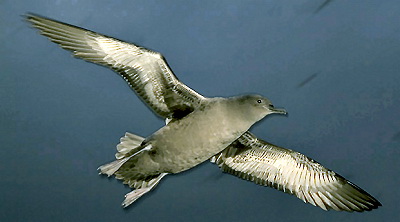| 새로운 사진 | 신문속의 동물소식 | 신기한 동물이야기 | 동물의 소리 | 동물동화상 | 사진 올리기 | 사진 저작권 | English |
|---|
| 재미있는 동물사진 | 괴수/괴어/엽기 동물사진 | 동물이름사전 | 동물목록 | 바깥고리 | 창고입구 | 똑똑누리집 |
|---|
| 이미지 정보 | Original File Name: Sooty Shearwater (Puffinus griseus).jpg Resolution: 400x222 File Size: 29694 Bytes Date: 2007:12:12 18:06:58 Upload Time: 2007:12:12 18:08:12 | |
| 올린이 | 이름 (메일주소): Unknown | |
| 사진 제목 | Sooty Shearwater (Puffinus griseus) - Wiki | |
 |
| Email : 카드 | 올린이 | 운영자 사진삭제 정보수정 Admin |
| 설명 | Sooty Shearwater (Puffinus griseus) - Wiki
Sooty Shearwater
The Sooty Shearwater (Puffinus griseus) is a medium-large shearwater in the seabird family Procellariidae. In New Zealand it is also known by its M??ori name t??t?? and as muttonbird, like the Wedge-tailed Shearwater and the Australian Short-tailed Shearwater. Systematics It appears to be related to the Great and Short-tailed Shearwater, all blunt-tailed, black-billed species, but its precise relationships are obscure. These are among the larger species of shearwater which might belong into a separate genus, Ardenna. Description This bird is 40-50 cm in length with a 95-110 cm wingspan. It has the typically "shearing" flight of the genus, dipping from side to side on stiff wings with few wing beats, the wingtips almost touching the water. Its flight is powerful and direct, with wings held stiff and straight, giving the impression of a very small albatross. This shearwater is identifiable by its dark Feather plumage which is responsible for its name. In poor viewing conditions it looks all black, but in good light it shows as dark chocolate-brown a silvery strip along the center of the underwing. In the pacific part of its range, other all-dark large shearwaters are found, but in the atlantic, it is the only such bird. Distribution and movements Sooty Shearwaters breed on small islands in the south Pacific and south Atlantic Oceans, mainly around New Zealand, the Falkland Islands and Tierra del Fuego. They are spectacular long-distance migrants, following a circular route, travelling north up the western side of the Pacific and Atlantic Oceans at the end of the nesting season in March-May, reaching sub arctic waters in June-July where they cross from west to east, then returning soth down the eastern side of the oceans in September-October, reaching to the breeding colonies in November. They do not migrate as a flock, but rather as single individuals, associating only opportunistically; in 1906 for example, two were shot near Guadalupe Island off Baja California (Mexico), several weeks before the bulk of the population would pass by. In the Atlantic Ocean, they cover distances in excess of 14,000 km (9,000 miles) from their breeding colony on the Falkland Islands (52°S 60°W) north to 60° to 70°N in the North Atlantic Ocean off north Norway; distances covered in the Pacific are similar or larger; although the Pacific Ocean colonies are not quite so far south, at 35° to 50°S off New Zealand, and moving north to the Aleutian Islands, the longitudinal width of the ocean makes longer migrations possible. Recent tagging experiments have shown that birds breeding in New Zealand may travel 74,000 km in a year, reaching Japan, Alaska and California, averaging more than 500 km per day. In Great Britain, they move south in late August and September; with strong N/NW winds, they may become 'trapped' in the shallow, largely enclosed North Sea, and heavy passages may be seen flying back north up the British east coast as they re-trace their steps back to the Atlantic over northern Scotland. Behavior The Sooty Shearwater feeds on fish and squid. They can dive up to 68 m deep for food, but more commonly take surface food, in particular often following whales to catch fish disturbed by them. They will also follow fishing boats to take fish scraps thrown overboard. It breeds in huge colonies and lays one white egg. These shearwaters nest in burrows lined with plant material which are visited only at night to avoid predation by large gulls. Vocalizations Usually loud, Sooty Shearwaters coo and croak while on the breeding grounds. Use by humans In New Zealand, t??t?? are traditionally harvested each year by the native M??ori. Young birds just about to fledge are collected from the burrows, plucked and often preserved in salt. As a consequence, the consumption of cooked t??t?? can be somewhat of a salty experience. http://en.wikipedia.org/wiki/Sooty_Shearwater
| |||
| 저작권 정보 | 사진의 저작권은 원저작자에게 있습니다. 동물그림창고는 동물관련 사진을 전시할 수 있는 공간만을 제공합니다.사진을 사용하고자 할 경우에는 저작권자와 협의하시기 바랍니다. |
|
|
|
| |||||||
| CopyLeft © since 1995, 동물그림창고. All rights may be reserved. | ||||||||
Stats